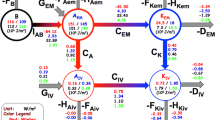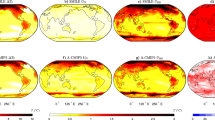Abstract
Until now, climate model intercomparison has focused primarily on annual and global averages of various quantities or on specific components, not on how well the general dynamics in the models compare to each other. In order to address how well models agree when it comes to the dynamics they generate, we have adopted a new approach based on climate networks. We have considered 28 pre-industrial control runs as well as 70 20th-century forced runs from 23 climate models and have constructed networks for the 500 hPa, surface air temperature (SAT), sea level pressure (SLP), and precipitation fields for each run. We then employed a widely used algorithm to derive the community structure in these networks. Communities separate “nodes” in the network sharing similar dynamics. It has been shown that these communities, or sub-systems, in the climate system are associated with major climate modes and physics of the atmosphere (Tsonis AA, Swanson KL, Wang G, J Clim 21: 2990–3001 in 2008; Tsonis AA, Wang G, Swanson KL, Rodrigues F, da Fontura Costa L, Clim Dyn, 37: 933–940 in 2011; Steinhaeuser K, Ganguly AR, Chawla NV, Clim Dyn 39: 889–895 in 2012). Once the community structure for all runs is derived, we use a pattern matching statistic to obtain a measure of how well any two models agree with each other. We find that, with the possible exception of the 500 hPa field, consistency for the SAT, SLP, and precipitation fields is questionable. More importantly, none of the models comes close to the community structure of the actual observations (reality). This is a significant finding especially for the temperature and precipitation fields, as these are the fields widely used to produce future projections in time and in space.



Similar content being viewed by others
References
AchutaRao K, Sperber KR (2006) ENSO simulation in coupled ocean-atmosphere models: are the current models better? Clim Dyn 27:1–15
Albert R, Barabasi A-L (2002) Statistical mechanics of complex networks. Rev Mod Phys 74:47–101
Arenas A, Diaz-Guilera A, Perez-Vicente CJ (2006) Synchronization reveals topological scales in complex networks. Phys Rev Lett 96:114102
Clauset A, Newman MEJ, Moore C (2004) Finding community structure in very large networks. Phys Rev E 70:066111
da Costa LF, Rodrigues FA, Travieso G, Villas Boas PR (2007) Characterization of complex networks: a survey of measurements. Adv Phys 56:167–242
Gneiting T, Raftery AE (2005) Weather forecasting with ensemble methods. Science 310:248–249
Gozolchiani A, Yamasaki K, Gazit O, Havlin S (2008) Pattern of climate network blinking links follow El Nino events. Europhys Lett 83:28005
Houtekamer PL, Derome J (1995) Methods for ensemble prediction. Mon Weather Rev 123:2181–2196
Kistler R et al (2001) The NCEP/NCAR 50-year reanalysis: monthly means, CD-ROM and documentation. Bull Am Meteorol Soc 82:247–267
Mirchev M, Duane G, Tang W, Kocarev L (2012) Improved modeling by coupling imperfect models. Commun Nonlinear Sci Numer Simul 17:2741–2751
Newman MEJ, Girvan M (2004) Finding and evaluating community structure in Networks. Phys Rev E 69:026113
Randall DA et al (2007) Cilmate models and their evaluation. In: Solomon S, Qin D, Manning M, Chen Z, Marquis M, Averyt KB, Tignor M, Miller HL (eds) Climate change 2007: the physical science basis. Contribution of working group I to the fourth assessment report of the Intergovernmental Panel on Climate Change. Cambridge University Press, Cambridge
Steinhaeuser K, Ganguly AR, Chawla NV (2012) Multivariate and multiscale dependence in the global climate system revealed through complex networks. Clim Dyn 39:889–895. doi:10.1007/s00382-011-1135-9
Strogatz SH (2001) Exploring complex networks. Nature 410:268–276
Swanson KL, Tsonis AA (2009) Has the climate recently shifted? Geophys Res Lett 36:L06711. doi:10.1029/2008GL037022
Tsonis AA, Swanson KL (2008) Topology and predictability of El Nino and La Nina networks. Phys Rev Lett 100:228502
Tsonis AA, Swanson KL, Roebber PJ (2006) What do networks have to do with climate? Bull Am Meteorol Soc 87:585–595. doi:10.1175/BAMS-87-5-585
Tsonis AA, Swanson KL, Kravtsov S (2007) A new dynamical mechanism for major climate shifts. Geophys Res Lett 34:L13705. doi:10.1029/2007GL030288
Tsonis AA, Swanson KL, Wang G (2008) On the role of atmospheric teleconnections in climate. J Clim 21:2990–3001
Tsonis AA, Wang G, Swanson KL, Rodrigues F, Da Costa LF (2011) Community structure and dynamics in climate networks. Clim Dyn 37:933–940. doi:10.1007/s00382-010-0874-3
Wang G, Swanson KL, Tsonis AA (2009) The pacemaker of major climate shifts. Geophys Res Lett 36:L07708. doi:10.1029/2008GL036874
Wyatt MG, Kravtsov S, Tsonis AA (2012) Atlantic multidecadal oscillation and northern hemisphere’s climate variability. Clim Dyn 38:929–949. doi:10.1007/s00382-011-1071-8
Yamasaki K, Gozolchiani A, Havlin S (2008) Climate networks around the globe are significantly affected by El Niño. Phys Rev Lett 100:228501
Acknowledgments
AAT is supported by Department of Energy USA grant DE-0005305. KS is supported by the National Science Foundation grant IIS-1029711. Access to computing facilities was provided by the Minnesota Supercomputing Institute.
Author information
Authors and Affiliations
Corresponding author
Electronic supplementary material
Below is the link to the electronic supplementary material.
Rights and permissions
About this article
Cite this article
Steinhaeuser, K., Tsonis, A.A. A climate model intercomparison at the dynamics level. Clim Dyn 42, 1665–1670 (2014). https://doi.org/10.1007/s00382-013-1761-5
Received:
Accepted:
Published:
Issue Date:
DOI: https://doi.org/10.1007/s00382-013-1761-5




